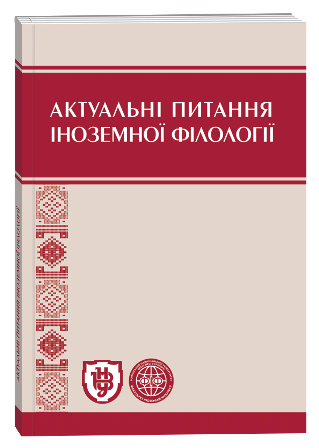АКТУАЛІЗАЦІЯ ОБРАЗНОГО СКЛАДНИКА ЕМОЦІЙНОГО КОНЦЕПТУ JOY В ТВОРЧОСТІ Г. К. ЧЕСТЕРТОНА
DOI:
https://doi.org/10.32782/2410-0927-2025-22-12Ключові слова:
Г. К. Честертон, когнітивна лінгвістика, когнітивна метафора, метафорична модель, індивідуально-авторське світобачення, образна складова концептуАнотація
Стаття є спробою визначення образного складника емоційного концепту joy в творчості відомого англійського письменника Г. К. Честертона. До дослідження було залучено різножанровий матеріал значного обсягу (філософсько-релігійні трактати, художня література, публіцистика) для уможливлення проведення детального аналізу образної складової концепту. Проблема емоційних концептів досить активно розробляється у зарубіжній та вітчизняній лінгвістиці, однак питання вивчення концепту joy у творах письменника ставиться вперше. У статті було розглянуто зміст концепту joy та виявлено, що його характер зумовлений не тільки самою суттю відповідної емоції, але й своєрідним світобаченням автора, яке базувалось на християнських традиціях радості та любові. Було також уточнено осмислення когнітивної метафори як ідеалізованої когнітивної моделі, яка відтворює бачення певного об’єкту як образу, структурованого через мовний знак. У ході розвідки було встановлено, що концепт joy у творах Г. К. Честертона об’єктивується перш за все лексемою joy та її 29 синонімами, що є прямими номінаціями концепту. До номінативних засобів мовної репрезентації цього концепту відносяться також прикметники у функції означення до лексеми joy, словосполучення (іменникові та дієслівні) із словом joy і його синонімічними відповідниками та низкою когнітивних метафор, які констатують образний зміст концепту. Головна увага у дослідженні була зосереджена на виявленні метафоричних моделей, за допомогою яких об’єктивується концепт joy в творах Г. К. Честертона. Вони наступні joy – essence of being, joy – spiritual value, joy – power, joy – cause of faith, joy – foundation of faith, joy – creativity. З’ясовано, що концепт joy є одним з базових у світосприйнятті та творчості письменника, стверджується також індивідуально-авторське значення концепту joy для визначення та осмислення інших базових концептів письменника – christianity, faith та god.
Посилання
Дорменєв В. Понятійний складник концепту "радість" у німецькій та англійській мовах. Науковий вісник Східноєвропейського національного університету імені Лесі Українки. Філологічні науки. Мовознавство. 2014. № 5. С. 75–79.
Польщак А. Л. Вічні цінності у книзі Ґ. К. Честертона «Ортодоксія». Наукові записки Харківського національного педагогічного університету імені Г. С Сковороди. Літературознавство. 2024. № 2 (102). С. 43-61.
Польщак А. Символізм і алегорія в романі Ґ. К. Честертона «Людина, яка була четвергом». Наукові записки Харківського національного педагогічного університету імені Г. С. Сковороди. Літературознавство. 2024. № 2 (104). С. 7-28.
Шамаєва Ю. Ю. Когнітивна стуктура концепту «радість» (на матеріалі англійської мови) : автореф. дис...канд. філол. наук: 10.02.04. ХНУ ім. В. Н. Каразіна, Харків. 2004. 20 с.
Cambridge Dictionary. Joy. URL: https://dictionary.cambridge.org/dictionary/english/joy.
Longman Dictionary of Contemporary English Online. Joy. URL: https://www.ldoceonline.com/dictionary/joy.
Chesterton G. K. A Miscellany of Men. Project Gutenberg. 2008. URL: http://www.gkc.org.uk/gkc/books/misc.html#2H_4_0014
Chesterton G. K. Alarms and Discursions. Dodd, Mead and Company. 1911. URL: http://www.gkc.org.uk/gkc/books/alarms_and_discursions.html
Chesterton G. K. Appreciations and Criticisms of the Works of Charles Dickens. Project Gutenberg. 2007. URL: https://www.gutenberg.org/files/22362/22362-h/22362-h.htm
Chesterton G. K. Robert Browning. Project Gutenberg. URL: https://www.gutenberg.org/files/13342/13342-h/13342-h.htm
Chesterton G. K. St. Thomas Aquinas. Project Gutenberg Australia. 2006. URL: https://gutenberg.net.au/ebooks01/0100331.txt
Chesterton G. K. The Ball and The Cross. Project Gutenberg. 2021. URL: https://www.gutenberg.org/cache/epub/5265/pg5265-images.html
Chesterton G. K. The Collected Works of G. K. Chesterton. Illustrated. Київ : Мультимедійне видавництво Стрельбицького, 2021. 4431 с.
Chesterton G. K. The Return of Don Quixote. Project Gutenberg Australia. 2013. URL: https://gutenberg.net.au/ebooks09/0900401h.html
Chesterton G. K. Varied Types. Project Gutenberg. 2024. URL: https://www.gutenberg.org/cache/epub/14203/pg14203-images.html
Chesterton on Joy. The Society of G. K. Chesterton. URL: https://www.chesterton.org/chesterton-on-joy
Collins Dictionary. Joy. URL: https://www.collinsdictionary.com/dictionary/english/joy;
Lakoff G. Women, fire and other dangerous things. What categories reveal about mind. Chicago : University of Chicago Press, 1987. 614 p.
Lakoff G., Johnson M. Metaphors we live by. London : University of Chicago Press, 2003. 277 p.
Merriam-Webster Dictionary. Joy. URL: https://www.merriam-webster.com/dictionary/joy;
Olkhovych-Novosadiuk M. The conceptosphere JOY in paremia of the English, Ukrainian and Polish languages. Science and Education a New Dimention. 2020. V. 230. I. VIII (38). P. 44–47
Oxford’s English Dictionary. Joy. URL: https://www.oed.com/search/dictionary/?scope=Entries&q=joy.







